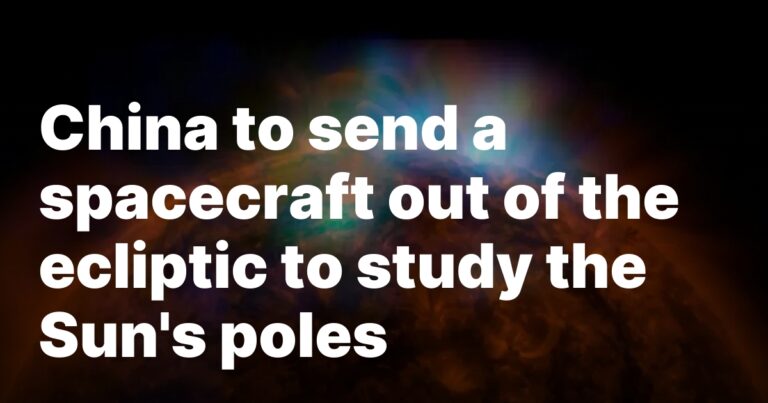HELSINKI — China plans to send a space observatory out of the plane of the ecliptic for a mission to study the poles of the sun.
The Solar Polar Orbit Observatory is currently scheduled to launch in 2029. The spacecraft will perform a gravity assist maneuver at Jupiter, altering its course to enter a high-inclination orbit around the Sun, enabling observations of the solar poles.
An orbit over the Sun’s poles would provide a vantage point that would offer unique data on solar magnetic activity cycles and high-speed solar winds. This perspective is crucial for understanding phenomena that directly impact Earth’s space weather and technological infrastructure.
The launch date comes from Luo Bingxian of the National Space Science Center (NSSC), who provided an overview of China’s space weather capabilities to the Scientific and Technical Subcommittee of the Committee on the Peaceful Uses of Outer Space (COPUOS) in Vienna, Austria, earlier this month.
China to launch the solar polar-orbit observatory mission in 2029 to study the Sun's poles pic.twitter.com/ais5t2Trid
— Andrew Jones (@AJ_FI) February 25, 2025
Only a handful of spacecraft have left the plane of the ecliptic, which is the geometric plane containing Earth’s orbit, extending outward through the solar system, and with which most of the planets are aligned. The Ulysses mission, launched in 1990 and active until 2009, orbited the Sun at around 80 degrees relative to the ecliptic to make solar observations. China’s solar polar-orbit observatory is expected to orbit with an inclination of around 60-70 degrees, according to earlier journal articles.
The solar polar orbiter mission is part of China’s wide-ranging National Space Science Medium- and Long-Term Development Plan (2024-2050) published in October.
Science objectives and payloads
The observatory aims to provide the first frontal imaging observation of solar polar regions, revealing the origin of the solar magnetic activity cycle, according to Luo. It will also produce a “Cloud Map” of Sun-interplanetary space, according to the presentation.
The Solar Polar-orbit Observatory will be equipped with a suite of advanced instruments to carry out its science objectives. Its remote sensing instruments include a Magnetic and Helioseismic Imager, which will analyze the Sun’s magnetic field and internal oscillations, and an Extreme Ultraviolet Solar Telescope to capture high-energy solar emissions. The spacecraft will also carry a Visible-light Coronagraph and a Very Large Angle Coronagraph, enabling detailed observations of the Sun’s corona and solar wind structures. A Low Frequency Radio Spectrometer will study solar radio bursts, while an X-ray Imaging Telescope will provide crucial insights into high-energy solar events.
Complementing these observations, in-situ instruments will be the Solar Wind Ion Analyzer, Energetic Ion Analyzer, and Magnetometer. These will directly measure solar wind properties and the interplanetary magnetic field, contributing to a comprehensive understanding of solar activity and its effects on the heliosphere.
Wider solar studies
The solar polar observatory will not be China’s first mission dedicated to studying the Sun. This mantle goes to the Chinese H-alpha Solar Explorer (CHASE) launched in October 2021. The mission, also known as Xihe-1, observes the Sun in the H-alpha waveband, providing valuable data on solar activities.
This was followed by the Advanced Space-based Solar Observatory (ASO-S), launched in October 2022. Also known as Kuafu-1, the probe focuses on observing solar flares, coronal mass ejections, and the solar magnetic field. China could also launch Xihe-2 to observe the Sun from the Sun-Earth L5 Lagrange point.
Other space agencies are engaged in advanced space-based solar studies. NASA launched the Parker Solar Probe in 2018 and in December made an approach as close as 6.1 million kilometers to the Sun. The spacecraft is providing scientists with key data on the solar wind and corona as it flies through it.
The collaborative European Space Agency (ESA) and NASA Solar Orbiter mission was launched in 2020 and carries a suite of instruments designed for high-resolution imaging and in-situ measurements, enabling detailed studies of solar activity and its effects on the heliosphere.
India’s Aditya-L1 launched in September 2023 and is positioned at the Sun-Earth L1 with seven payloads for studying the solar atmosphere, magnetic field, and solar wind. Meanwhile, ESA’s Proba-3 mission consists of an Occulter and Coronagraph spacecraft flying in precise formation to emulate total solar eclipses to allow study of the solar corona.

